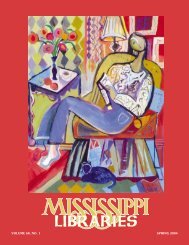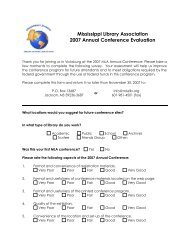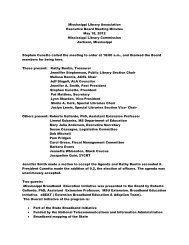Full Text (PDF) - Mississippi Library Association
Full Text (PDF) - Mississippi Library Association
Full Text (PDF) - Mississippi Library Association
You also want an ePaper? Increase the reach of your titles
YUMPU automatically turns print PDFs into web optimized ePapers that Google loves.
Page 10 Vol. 75, No. 1, Spring 2012 <strong>Mississippi</strong> Libraries<br />
should be demonstrated. For the databases,<br />
keyword searching and the use of<br />
abstracts, as well as search vocabulary,<br />
such as broader, narrower, or related terms<br />
should be demonstrated. Truncation, nesting,<br />
and Boolean operators also must be<br />
explained. An understanding of all is necessary<br />
for successful database searching,<br />
and all should be covered during the<br />
instruction session.<br />
Evan Farber observed that “[t]he oneshot,<br />
one-class period of library instruction<br />
has always been hard to get, yet once gotten<br />
rarely seemed enough to provide as<br />
much instruction as one felt appropriate.<br />
But now, with teaching the variety of databases<br />
within the library or available online,<br />
added to all the basic instruction, fifty minutes<br />
is hardly adequate” (Farber 1999,<br />
233). Since Farber wrote this, many<br />
libraries have created instruction labs with<br />
multiple computer workstations to accommodate<br />
real-time searching by students,<br />
and this activity further reduces the time<br />
available to the librarian for actual instruction.<br />
The librarian’s not having enough<br />
time to address all s/he should, yet feeling<br />
compelled to cover as much as s/he can,<br />
can lead to the result that “[o]ne-time lectures<br />
often serve more to confuse than<br />
enlighten; so much information is stuffed<br />
into one hour that very little is retained”<br />
(Self and Kampe 1980, 20).<br />
As an instruction librarian, I have long<br />
been frustrated by these conflicting<br />
demands and the disjunction between the<br />
subject faculty member’s short-term goals<br />
for the library session and the instruction<br />
librarian’s long-term concerns regarding<br />
information literacy for lifelong learning,<br />
and the insufficiency of time to address<br />
both. I had become a Vitruvian Man.<br />
Pulled in too many directions, I needed to<br />
achieve balance and proportion by reconciling<br />
long-term with short-term in my<br />
instruction sessions.<br />
Instruction at Houston Cole <strong>Library</strong><br />
My library, the Houston Cole <strong>Library</strong> of<br />
Jacksonville State University, is a tower<br />
library of twelve stories plus a basement<br />
(which houses our technical services<br />
department and instruction SmartLab of<br />
thirty-plus computer workstations, as well<br />
as other offices). Of the twelve aboveground<br />
floors, eight contain the library’s<br />
collection. The building dictates the collection<br />
arrangement, and the collection<br />
arrangement determines the staffing pattern.<br />
Houston Cole <strong>Library</strong> does not have<br />
a generalist librarian position in its public<br />
services department; instead, each floor is<br />
staffed by a subject specialist with an<br />
advanced degree and/or experience with<br />
the subject(s) collected on the particular<br />
floor on which s/he serves. In addition to<br />
collection development duties, each subject<br />
specialist is responsible for providing<br />
information literacy/library instruction to<br />
classes taught by subject faculty whose<br />
subject matter is collected on that specialist’s<br />
floor.<br />
Since my floor, the seventh, houses the<br />
English and American literature collections,<br />
I am the literature subject specialist for<br />
Houston Cole <strong>Library</strong>. Along with my reference<br />
and collection development responsibilities,<br />
I provide instruction for freshman<br />
English classes and particularly the class for<br />
second semester freshman composition –<br />
a staple of which is the research paper on a<br />
literary topic. Since freshman composition<br />
is a course which nearly every freshman<br />
must take, over the course of an academic<br />
year this can amount to a lot of instruction<br />
sessions for me.<br />
Even in the print era, I always used<br />
handouts in my instruction sessions, in the<br />
hope that the handout would encourage<br />
students to take some notes and that notes<br />
written on a task-specific handout would<br />
be easier to locate later than notes scrawled<br />
in a notebook which soon would be filled<br />
with other notes. The arrival of online<br />
searching, electronic databases, and<br />
SmartLabs equipped with computer workstations<br />
presented the additional challenge<br />
of having to teach more than three things<br />
while trying to minimize the students’ content<br />
overload; teaching to the assignment<br />
so as to meet the subject faculty member’s<br />
wishes and expectations for the instruction<br />
session, and at the same time trying to<br />
avoid the problem with the one-shot lecture<br />
which James R. Self and Patricia C.<br />
Kampe identified: “Students learn specific<br />
titles and specific skills, rather technical in<br />
nature and limited in application. They<br />
have difficulty adapting these specific skills<br />
to other . . . research projects” (Self and<br />
Kampe 1980, 20).<br />
After many disappointing starts leading<br />
to unsatisfactory results, I finally developed<br />
a handout which balances many, if not all,<br />
of the conflicting demands imposed by the<br />
one-shot lecture. Unlike previous handouts<br />
I had tried, which included everything from<br />
lists of print reference materials to screen<br />
captures to Venn diagrams, this handout is<br />
much more focused and far less “busy.” I<br />
made a version for first semester freshman<br />
composition and another for second<br />
semester freshman composition, the principal<br />
difference being that the second<br />
semester handout is focused on literary<br />
research for the term paper. With the first<br />
semester comp. classes, I spend more<br />
time with the online catalog; and, since<br />
these classes usually come to the library<br />
with general assignments, or sometimes<br />
with no assignment at all, I highlight a different<br />
group of databases.<br />
Aside from this difference, my approach<br />
to each handout and my classroom presentation<br />
are the same: I walk the students<br />
through the handout, demonstrating the<br />
procedures outlined on it, and then toward<br />
the end of the session provide an opportunity<br />
for students to perform the searches I<br />
have demonstrated on their own using their<br />
own topics, while my demonstration is still<br />
fresh in their minds. After a few opening<br />
remarks at the beginning of the library session,<br />
I lock down the students’ computer<br />
workstations to my instructor’s keyboard,<br />
and they remain locked until I release them<br />
at the end of the lecture/demonstration so<br />
the students can perform their own searches.<br />
Because I provide instruction sessions<br />
mainly for the second semester freshman














